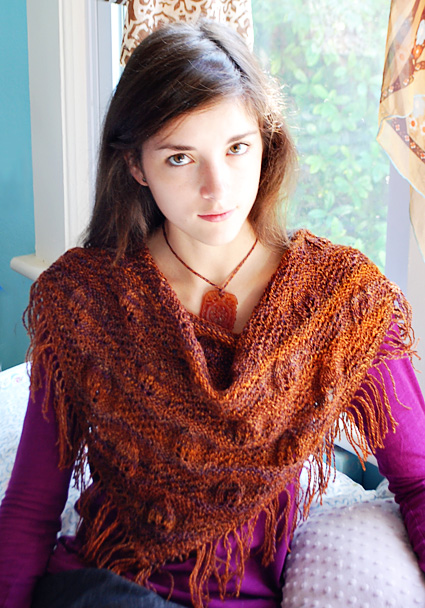
 |
|
|
 |
Throw this leafy triangle around your neck or wrap it with a pin, add fringe or leave it plain. Any way you chose, you’ll find this easy lace pattern addictive. Since it looks great in any yarn weight you’ll definitely be knitting more than one. The secret is to use larger needles than recommended for the yarn, maybe 2 sizes, maybe 4, depending on the body of your chosen yarn. Spinners will love the scrumptiousness of Three Waters Farm Blue Face Leicester/Tussah Silk fiber, shown here in Canyonlands. The body and luster of this fiber make it perfect for lace yarns, and the colorway is, dare we say, indigenous, natural, chameleonesque. The Three Waters Farm Organic Merino Sport would also work very nicely. The pattern is built on tiers of alternating bee stitch and leaf stitch squares. Easily memorized, this pattern can be repeated to form any size triangle. Suggested yardage is included for two versions. |
After the setup triangle, each tier begins the same way, with a right hand bee triangle and a leaf square. The first tier finishes with a left hand bee triangle. The second tier inserts a pair of bee/leaf squares. Each successive tier inserts one more pair of squares. Separate each square with stitch markers and it’s a cinch to keep your place in the pattern. |
|
|
|
|
|
SIZE |
|
FINISHED MEASUREMENTS Commercial version: |
|
MATERIALS Finished Yarn Drafting Method
Tools |
|||||
|
GAUGE |
| Handspun: 16 sts/28 rows = 4 inches in stockinette stitch 9 sts/18 rows = 3 inches in leaf pattern stitch Commercial: 14 sts/24 rows = 4 inches in stockinette stitch 12 sts/24 rows = 4 inches in leaf pattern stitch |
|
PATTERN NOTES |
|
Bee Stitch
Single Crochet/K2tog Bind Off Ch: Chain "Knitchet": Working
Crochet With Two Knitting Needles If you’ve got a hook, more traditional crochet instructions
can be found here. |
The charts for this pattern are very large and fit on a letter-sized page. Click here and print the resulting page. |
|
DIRECTIONS Tier One (Right
Side bee triangle, marker, Leaf Square, marker,
Left Side Bee Triangle) Row 31 [RS]: K1, yo, k1b, place marker, **p9, slip marker, [k1b, k1] four times, k1b**, slip marker, p9, place marker, k1b, yo, k1. Row 32 [WS]: Knit. Tier Three: (Right
Side Bee Triangle, Leaf Square, Bee Square,
Leaf Square, Bee Square, Leaf Square, Left Side
Bee Triangle) Tier Four: Follow instructions for Tier Two, repeating directions between pairs of ** 3 times. Tier Five: Follow instructions for Tier
Two, repeating
directions between pairs of ** 4 times. Knit until you have completed desired number of Tiers.
Bind off using Single Crochet/K2tog Bind-off (see notes). |
|
FINISHING At both top side corners of the triangle, tie three strands of fringe (two from the first pair and one from the next working towards the point of the triangle) with an overhand knot. Working towards the point, take one strand from each neighboring pair and tie them together with an overhand knot. |
| ABOUT THE DESIGNER |
|
Eat, sleep, spin, knit, (dye, crochet,
weave, felt) usually with dog attached
and hubby looking on. |
|
Pattern & images © 2010 Lynne Vogel. Contact Lynne |